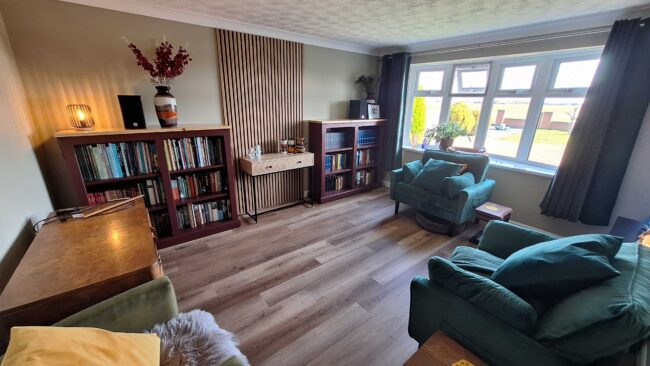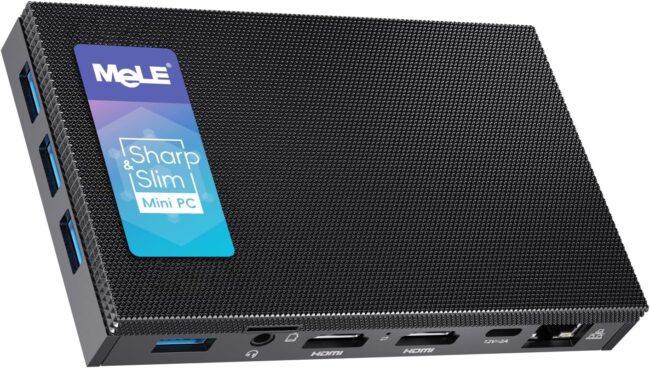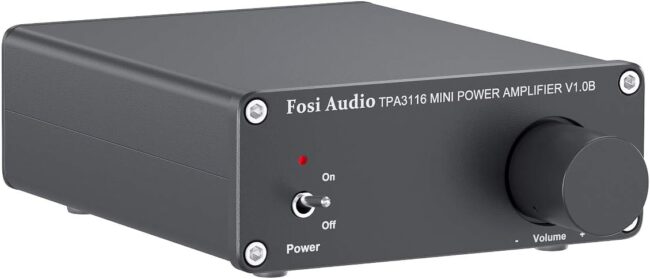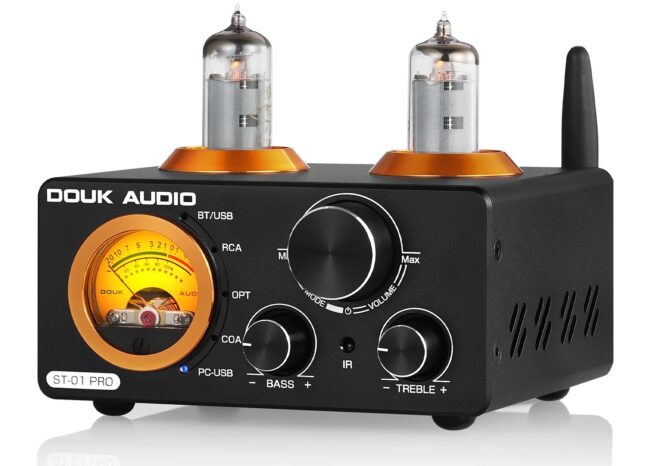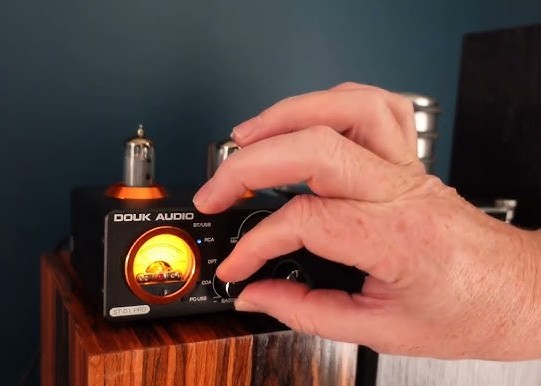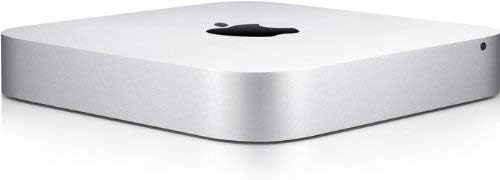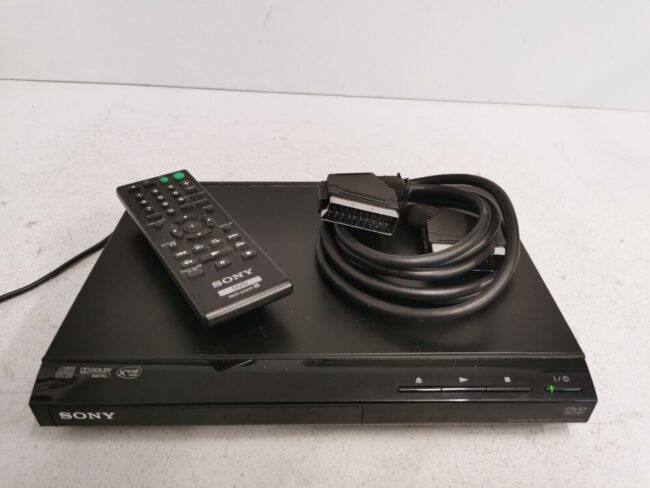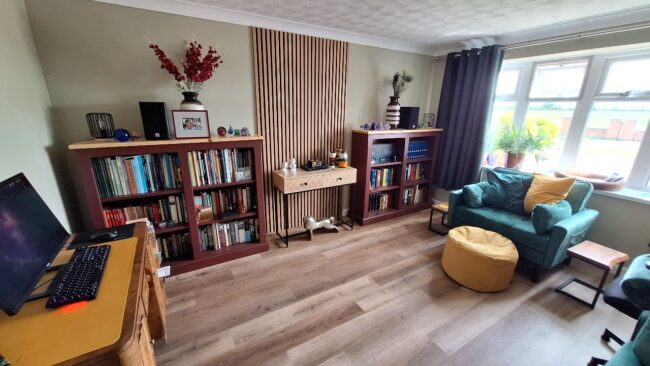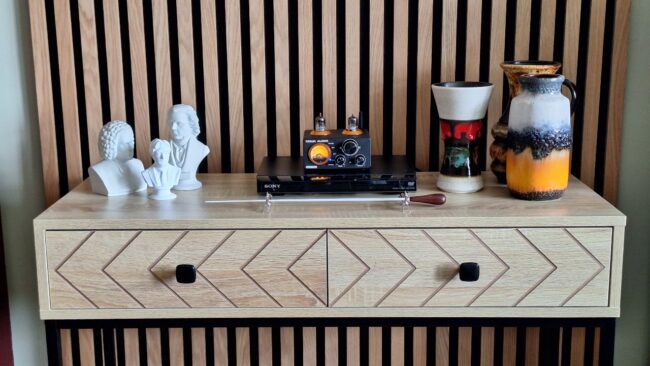My listening room audio hardware used to look like this:
Hopefully, the immediate response on seeing that is: where is it?! I was after a 'mostly invisible' vibe for this incarnation of my happy place! Rest assured, it's all there, in the centre console. In the right-hand drawer of said console sits this:
That's a MeLE Quieter3Q PC, using an Intel N5105 CPU that runs cool and, with only passive cooling, totally silently. It runs Fedora, though it ships with Windows 11, and is connected via ethernet to my main music server sitting in my loft. I control it from another silent-running PC (that sits inside my desk) via an SSH connection: it runs Giocoso and displays its output on my main PC's desktop. I can also connect to the MeLE PC from my phone, so if I'm sitting in an armchair away from the desk, I can fire up mgiocoso via SSH and control the already-running Giocoso session from there. This, then, is the digital music source.
It pipes its digital musical goodness via hidden-inside-the-console wiring to this in the left-hand drawer:
This is the Topping E30 DAC (Digital to Audio Converter). It takes in a digital signal from the PC and turns it into an analog audio signal that can be piped to this:
That's a Fosi Audio v.1.0B integrated amplifier. It connects via standard speaker cables that I had embedded into the plaster work in the back wall to the two Dali Spektor 2 speakers you see sitting on my bookshelves.
So, the complete music playback pathway was: a network share of music files → MeLE PC→ Topping E30 DAC → Fosi Audio amplifier → Dali Spektor 2 speakers. It all worked fine for years on end, until one day it suddenly didn't! For reasons I could never really fathom, the USB connection between the PC and the DAC simply stopped functioning one day and I could never get it working again. I installed new distros on the PC until I was blue in the face, all without success. Every distro could see the Topping E30: if you did an aplay -l for example, it would be listed in the available output devices. All of them failed to output anything to the DAC, however, and I couldn't work out why.
In desperation, I resurrected an ancient PC with an optical-out port, bought a toslink cable to connect the PC to the DAC via a digital optical connection... and everything sprang back into life once more. Good news, then... except that it turns out that whilst you can control the volume of a signal passed from PC to DAC using USB with software (such as alsamixer), you can't do that with the toslink signal: that's either on or off and there's no ability to turn it up or down. This meant that my previous ability to fire up alsamixer on my phone and control the playback volume from the comfort of my armchair had been lost: now I had to get up from my seat, open the left-hand drawer and blindly fiddle with the Fosi amplifier's volume control knob to achieve an appropriate level of loudness or quietness. That didn't seem entirely satisfactory to me!
What was needed, of course, was a new integrated amplifier that had a remote control capability, allowing the volume knob to be controlled without physical interaction. There are quite a few such amplifiers available on the market, all suffering from the fatal flaw that the remote control is done with infrared... which necessitates a line-of-sight between the remote control and the amplifier. Hiding the amplifier inside the console drawer wouldn't be an option if I went down this route: it would have to sit on top of the console, in plain sight. Given that plain sight visibility was going to be needed, it seemed sensible to look for a class D integrated amplifier that not only handled assorted digital inputs (including toslink) and had a remote control capability but was simultaneously reasonably attractive to look at, so that no longer hiding in the drawer didn't detract from my listening room's visuals too badly. After an exhaustive search, I settled on this:
That's a Douk ST-01 Pro. Not only is it an integrated amplifier with remote control, it is a hybrid integrated amplifier, because (as is pretty obvious from the picture!) it uses old-fashioned valves (or "tubes" as our American cousins would call them) as well as solid state circuitry to work its amplification magic. It's got a VU meter too, so if you care to, you can see a needle bouncing around as music plays, which can be weirdly pleasing!The whole thing has a quasi-Gothic, steampunk vibe about it which I might once have dismissed as affectation... but which my more nostalgic self these days rather appreciates 🙂 It's also tiny: here's a stock marketing image with a human hand (definitely not mine!) to give some sense of scale:
Two other features are also worth mentioning: first, the little black aerial at the rear of the device tells you this thing can receive Bluetooth broadcasts -so my phone can now connect to this as it plays video from YouTube, say: my listening room just became a video-watching room whenever the mood takes me. Second, but not as obvious, the device contains an integrated DAC, fed by USB, toslink optical or audio coaxial connections. I could ignore its existence, of course, and keep feeding my digital audio sources through the Topping DAC... but if I choose to make use of it, this one device is capable of rendering both the Topping E30 DAC and the Fosi Audio amplifier redundant, as it provides the same functionality of both in a single unit.
The only issue at this point is how to feed a digital signal into the new amplifier. I had long since had enough trying to persuade the MeLE PC to pipe digital music via its USB port. What I needed, therefore, was a silent (or near-silent) PC that could run inside the drawer of the console unit, but with an optical out port that could go direct to the Douk. Enter this thing from the cupboard of forgotten, ancient hardware and last resort:
It's an Apple Mac Mini (Late 2012), using an Intel i5 processor. I bought mine second-hand, off Ebay, years ago: it has languished unused for at least three years at this point. But it still works and, something I hadn't realised until just this past month, it has integrated optical out. On the rear port, it has a 3½mm headphone port, which I had always assumed was literally just that: somewhere you stuck your headphones into. But no: it turns out that from about 2007 to 2018, all Apple Mac Minis integrated a toslink optical out into the same port: plug a mini-toslink-to-toslink cable into that and the Mac Mini can then communicate directly with the Douk amplifier: the Topping and Fosi devices can retire honourably to the aforementioned discard-cupboard, duty done! I'll mention in passing that the Mac Mini now runs Fedora 42: I love Apple hardware but loathe its operating system. Giocoso runs happily on Fedora 42 and I can ssh into the Mac without drama to control it remotely from my main PC or phone, as before with the MeLE. Finally, it's worth mentioning that though the Mini uses a fan, it's so quiet that I simply cannot hear it, especially when it's in the closed console drawer!
So now my music path is: Mac Mini → Douk ST-01 Pro amplifier → Dali Spektor 2 speakers: much simpler than before, you'll note. As a bonus I can also do Samsung Phone → Douk → Speakers, using Bluetooth. There is now only one device hiding in the console drawers: the Mac Mini. The Douk amplifier sits on top of the console, simply for the necessary line-of-sight remote control-abilty (and the undesirability of sticking a couple of red-hot glowing valves inside a closed drawer!) There are fewer cables to keep tidy and fewer devices to be generating heat in the confined space of a drawer.
It was at this point that it occurred to me that whilst the Douk accepts toslink, bluetooth, USB and coaxial audio inputs, I was only using two of those connections. So I decided to splash out on one of these:
It's a very basic Sony DVD player, specifically a DVP-SR160, second-hand from Ebay at the princely sum of around £20.It has no display to speak of: playback starts when you press the play button and that's your lot: you can certainly play specific tracks by typing in numbers on the remote, but there's nothing to indicate what track is playing at any given time... which is exactly how I like my classical music to be played! Giocoso doesn't play tracks either, for the very good reason that I hate them. So, cheap and cheerful it may be, but it works exactly as I would wish and for peanuts on the pound, too! I did need to buy an additional digital coaxial cable, at another £6 or so, to get it connected to the Douk... but with that done, it all sounds pretty marvellous.
However, I hardly ever play physical media these days and don't intend to play much of it in the future! My main music collection is, however, approaching 3TB in size and I'm running out of disk space for it, so at the back of my mind, it seemed a reasonable idea to be able to audition a CD before committing to ripping it and adding it to the main collection. I have, for example, raided the local charity shops for their cheap CDs and then just binned some because, having ripped them, they didn't live up to expectations. The flimsy pretext for my purchase is therefore that I shall now be able to check a purchase before spending effort ripping and tagging it.
In short, my audio reproduction system used to be: MeLE PC → Topping E30 → Fosi Audio amplifier → Dali Spektor 2 speakers. It is now:
- Mac Mini → Douk ST-01 Pro amplifier → Dali Spektor 2 speakers (using toslink)
- Samsung Android Phone → Douk ST-01 Pro amplifier → Dali Spektor 2 speakers (using Bluetooth)
- Sony DVD Player → Douk ST-01 Pro amplifier → Dali Spektor 2 speakers (using coaxial)
Armchair functionality is restored once more, and everything sounds as perfect as I could wish.
My system is obviously not "audiophile quality", but my old ears are simply not worth £20,000. I rather think £500 is pushing the boat out for them, to be honest! But I am happy with the result, in both audio and aesthetic terms:
And zooming in on the console:
There are now some visible bits and pieces that weren't there before, but I don't think the overall aesthetic has been ruined... and there are still no visible wires to upset me!
Incidentally, if you were thinking of doing something similar for yourself, note that the Mac Mini's toslink audio output is limited to 96KHz/24-bit. That's a sampling rate that actually and physically accommodates every conceivable human listening requirement... but someone's bound to moan that it isn't DSD- or SACD-quality. In that case, you'd need to use a Late 2014 Mac Mini instead: uniquely, that particular Mac Mini release had the specs on the toslink output upgraded, such that it supported 192KHz/24-bit audio. I shan't bother, because my ears would never hear the difference, but your mileage (and desire for bragging rights) might vary. Stop press: Immediately having written the last sentence, I regretted it and went out and bought a Late 2014 Mac Mini for another £40. My ears will still never know the difference, but my inner perfectionist will have been satisfied! It's still sitting invisibly in the right-hand draw...
By way of conclusion, I'd simply like to recommend the Douk ST-01 Pro: it is clear, bright and stages the audio rather well. I also still recommend the Topping E30 DAC ...and the little Fosi Audio V1.0B is an effective enough amplifier, too. Those two bits of hardware are now, however, surplus to my requirements and a trip to Ebay to dispose of them seems a likely next step. There's also the Mac Mini 2012 to dispose of, I suppose.
Anyway: it's been a bit of an unfolding journey for the last couple of months and I thought the tale worth telling! Hopefully something here might inspire your own audio hardware experiments, if you haven't already got all the technology in place.
